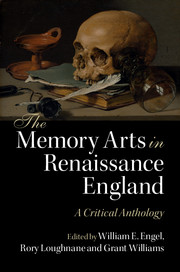Book contents
- Frontmatter
- Dedication
- Contents
- List of figures
- Acknowledgements
- A note on abbreviations
- Introduction
- PART I The art of memory
- PART II Rhetoric and poetics
- PART III Education and science
- Introduction to Part III
- III.1 Thomas Elyot, The Governor (1531)
- III.2 Roger Ascham, The Schoolmaster (1570)
- III.3 Levinus Lemnius, The Touchstone of Complexions (1576)
- III.4 William Kempe, The Education of Children (1588)
- III.5 John Brinsley, Ludus literarius (1612)
- III.6 Robert Burton, The Anatomy of Melancholy (1621)
- III.7 Thomas Sprat, The History of the Royal Society (1667)
- III.8 John Wilkins, An Essay towards a Real Character (1668)
- III.9 Obadiah Walker, Of Education (1673)
- III.10 Robert Hooke, ‘An Hypothetical Explication of Memory’ (1682)
- PART IV History and philosophy
- PART V Religion and devotion
- PART VI Literature
- Index
- References
III.8 - John Wilkins, An Essay towards a Real Character (1668)
from PART III - Education and science
Published online by Cambridge University Press: 05 August 2016
- Frontmatter
- Dedication
- Contents
- List of figures
- Acknowledgements
- A note on abbreviations
- Introduction
- PART I The art of memory
- PART II Rhetoric and poetics
- PART III Education and science
- Introduction to Part III
- III.1 Thomas Elyot, The Governor (1531)
- III.2 Roger Ascham, The Schoolmaster (1570)
- III.3 Levinus Lemnius, The Touchstone of Complexions (1576)
- III.4 William Kempe, The Education of Children (1588)
- III.5 John Brinsley, Ludus literarius (1612)
- III.6 Robert Burton, The Anatomy of Melancholy (1621)
- III.7 Thomas Sprat, The History of the Royal Society (1667)
- III.8 John Wilkins, An Essay towards a Real Character (1668)
- III.9 Obadiah Walker, Of Education (1673)
- III.10 Robert Hooke, ‘An Hypothetical Explication of Memory’ (1682)
- PART IV History and philosophy
- PART V Religion and devotion
- PART VI Literature
- Index
- References
Summary
About the author
John Wilkins (b. 1614, d. 19 November 1672), a founding member and active fellow of the Royal Society, was one of the pre-eminent natural philosophers of the seventeenth century.
About the text
Wilkins's project responds to one of the era's most vexing epistemological problems: the English language with its rhetorical excess, grammatical idiosyncrasy, and verbal arbitrariness impedes the clear transmission of knowledge and truth. So grave was the situation, even the Royal Society sought to establish mathematical plainness and precise expression in scientific communication so that the order of thoughts could achieve congruence with the order of things. Wilkins's Essay thus formulates a universal language that would be advantageous to ‘facilitating mutual commerce’, improving ‘Natural Knowledge’ and ‘spreading of the knowledge of Religion’. In effect, it seeks to reverse the curse of Babel (Genesis 11:1–9), by which God punished a united mankind for building a tower the height of heaven. God confounded the single language of the builders and caused it to split into diverse tongues, which were scattered throughout the earth.
Wilkins designed his artificial language to produce ‘the shortest and plainest way for the attainment of real knowledge’ by categorising things and notions, dividing them into their subgroups and assigning them letters and symbols. Combining or interpreting symbol and letter sequences enabled the practitioner to create or discern meaning. Wilkins's artificial language categorises all knowledge into various classes and subclasses. A Ramist-like chart maps out the relations among forty genera (or ‘more common heads of things’); see Figure III.2. Each genus is subdivided into ‘differences’ (252 in total), and each class of ‘difference’ is further subdivided into ‘species’ (2,034). For example, he divides the genus ‘beast’ (XVIII) into six ‘differences’ from ‘whole-footed’ to ‘oviparous’. In the first ‘difference’ there are four species of ‘whole-footed’ beasts: horse, ass/mule, camel and elephant. The first species, ‘horse’, also indicates ‘mare, gelding, nag’, etc. A ‘horse’, or its associated species, is thus the first species of the first difference of the eighteenth genus. Wilkins's ‘Real Character’ uses written symbols – a straight line overwritten with a series of various strokes, hooks and loops – to indicate the genus, difference, and species. With his ‘philosophical language…made effable’ (i.e. to be spoken aloud), Wilkins assigns each genus a certain combination of letters.
- Type
- Chapter
- Information
- The Memory Arts in Renaissance EnglandA Critical Anthology, pp. 171 - 176Publisher: Cambridge University PressPrint publication year: 2016



